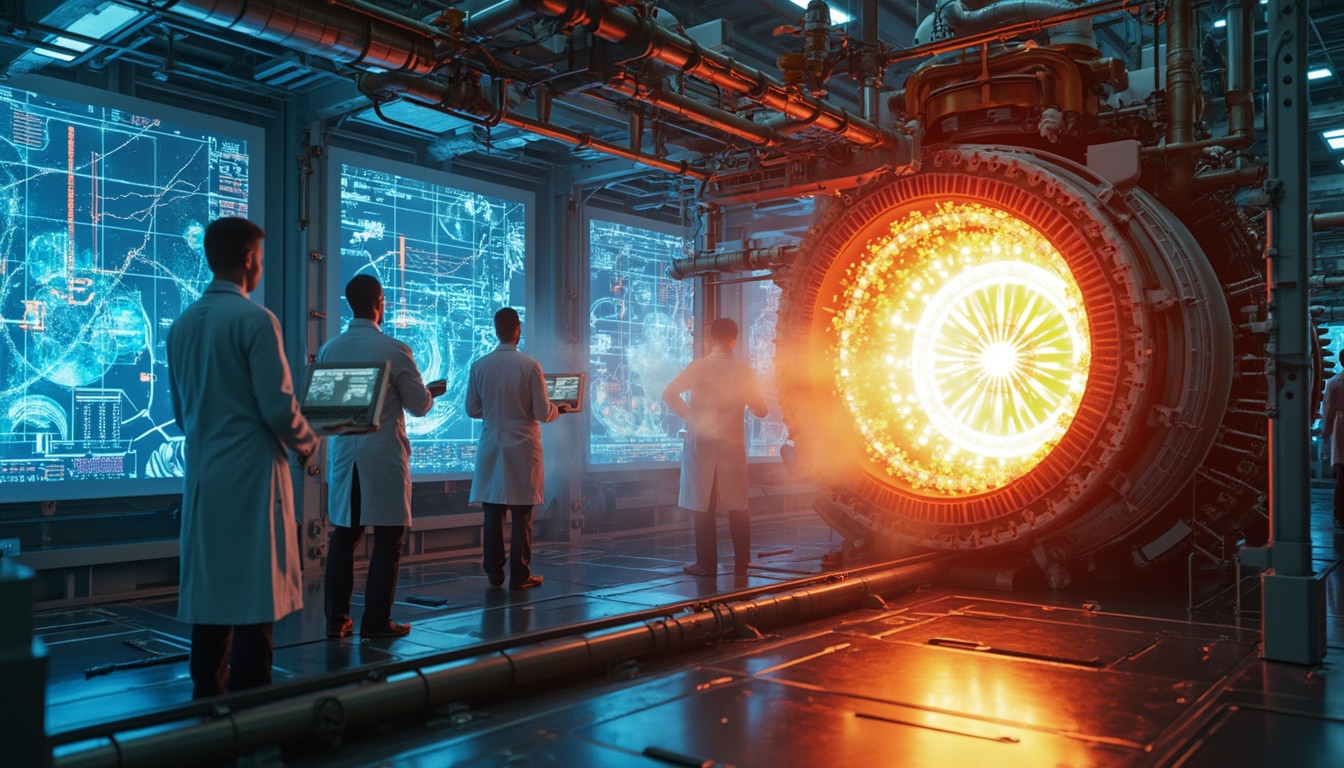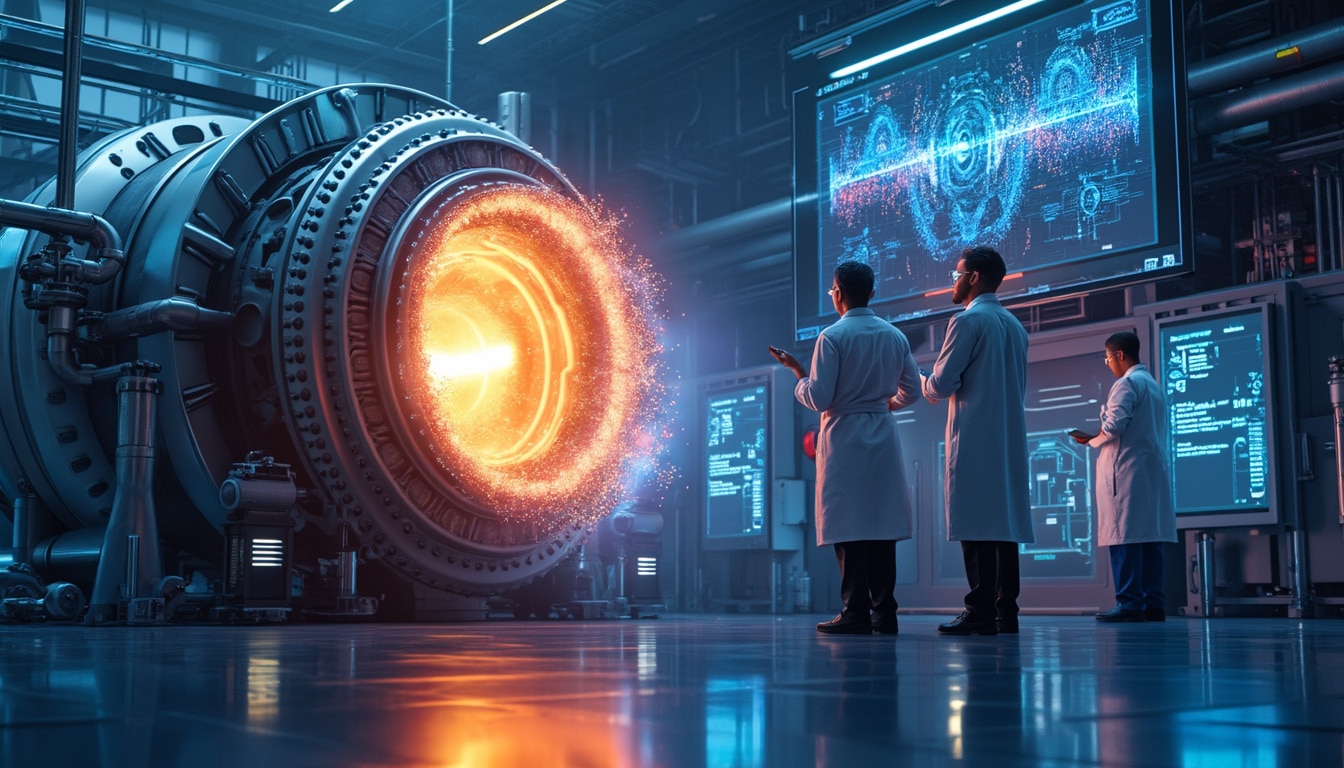The dawn of a new energy era is breaking as fusion technology makes its grand entrance into the industrial stage.
With the installation of Tokamak SPARC in an experimental facility, we’re witnessing a seismic shift in how we power our world.
This isn’t just another high-tech gadget; it’s a bold leap towards sustainable energy that could redefine our future.
Commonwealth Fusion Systems (CFS) has turbocharged the race by developing a compact tokamak inspired by ITER but slashing both size and costs. By drumming up a chill environment at a staggering -253°C, SPARC aims to coax plasma into existence by 2027. Leveraging lessons from past fusion flops, CFS is sprinting towards a goal where more energy is produced than consumed. As global projects accelerate, the promise of fusion energy lights up the horizon with both excitement and a few raised eyebrows.

Welcome to the thrilling world of nuclear fusion, where magnetic fields dance at 100 million degrees and scientists are racing against time (and thermals) to unlock the power of the stars right here on Earth. At the heart of this cosmic hustle is the Tokamak SPARC, a compact fusion reactor that’s turning heads and heating up the competition in the global pursuit of clean, limitless energy.
Table of contents
Togglewhat makes tokamak sparc stand out in the fusion landscape
The Tokamak SPARC isn’t your grandpa’s fusion reactor. Developed by Commonwealth Fusion Systems (CFS) out of MIT, SPARC is a sleek, compact tokamak inspired by the massive ITER project, but it’s hitting the energy scene with a fraction of the size and cost. Imagine having a supercar compared to ITER’s freight train—SPARC is designed to prove that you don’t need to break the bank (or the space station) to achieve stellar fusion feats.
In March, CFS installed the cryogenic base essential for cooling superconducting magnets to a chilly -253°C. These magnets are the unsung heroes that keep the plasma, a hot soup of charged particles, in line, preventing it from touching the reactor walls. This technical milestone is more than just a chill achievement; it’s a stepping stone towards generating more energy than SPARC consumes by 2027. As Alex Creely, CFS’s director of operations, puts it, « We’ve learned from ITER’s mistakes and optimized our supply chain, making fusion energy a bit more attainable. »
how tokamak sparc differs from traditional fusion reactors
While ITER has been the poster child for fusion for years, SPARC is shaking things up with its design philosophy. ITER’s approach is grandiose and expensive, often requiring international collaboration and billions in funding. In contrast, SPARC is leaner, faster, and more cost-effective, proving that size doesn’t always equate to power (literally).
The compact design of SPARC allows for quicker iterations and innovations, setting the stage for more agile advancements in fusion technology. By leveraging lessons learned from ITER, CFS has streamlined the assembly process and tapped into existing supply chains, accelerating the timeline from laboratory to operational reactor. This nimbleness is crucial in the race to make nuclear fusion a viable energy source, offering a tantalizing glimpse of a future powered by the same reactions that fuel our sun.
what’s the current state of global fusion projects
SPARC isn’t sprinting alone on the fusion track. Around the globe, several ambitious projects are pushing the boundaries of what’s possible in nuclear fusion. In China, the Experimental Advanced Superconducting Tokamak (EAST) has achieved a plasma stability record of 1,066 seconds, holding the line for nearly 18 minutes. Meanwhile, France’s tokamak WEST demonstrated its prowess by maintaining plasma at a scorching 50 million degrees Celsius for six minutes, showcasing the resilience of new materials like tungsten.
Over in Canada, General Fusion is making waves with its LM26 prototype, built in a mere 16 months and already generating plasma. This rapid development underscores the dynamism of the North American fusion sector, hinting at a vibrant future filled with innovative reactor designs and breakthroughs.
But it’s not just about hardware. In February 2024, Princeton’s team integrated AI into plasma control, allowing the system to predict and counteract instabilities up to 300 milliseconds in advance. This leap in real-time reaction management could be a game-changer for SPARC and future reactors, preventing sudden shutdowns and sustaining plasma reactions longer. Such advancements are detailed in InnonaNews’ review of 2024’s top science breakthroughs.
how artificial intelligence is shaping fusion energy
The marriage of AI and fusion energy is creating sparks—both literally and figuratively. By harnessing machine learning algorithms, researchers can now predict plasma behavior, optimizing conditions for sustained reactions. This synergy not only increases efficiency but also reduces the trial-and-error phase, accelerating the path to practical fusion power.
Princeton’s AI-driven control systems represent a monumental step forward, enabling reactors like SPARC to maintain stability in real-time. This technology could be the linchpin that turns fusion reactors from experimental setups into reliable power sources. For a deeper dive into how AI is chilling things down in unexpected ways, check out this insightful piece on AI advancements.
what challenges remain for tokamak sparc and fusion energy
Despite the exciting progress, the road to sustainable fusion energy is anything but smooth. One of the biggest hurdles for Tokamak SPARC is achieving stable plasma confinement at over 100 million degrees Celsius. The cryostat must endure extreme thermal fluctuations, transitioning from 100 million degrees to 1,000°C over just 30 centimeters. This demands not only precision engineering but also materials that can withstand such stress without faltering.
Another significant challenge is the production of tritium, a rare isotope of hydrogen that serves as fuel for fusion reactions. Tritium must be generated within the reactor itself, adding another layer of complexity to the process. Moreover, no fusion reactor has yet produced electricity continuously in a cost-effective manner, a crucial milestone for commercial viability.
These impediments underscore the fact that while we’re making impressive strides, the journey to fusion-powered cities is still a long one. Each breakthrough brings us closer, but the final leap requires overcoming these persistent barriers with ingenuity and investment.
the rise of stellarators and alternative fusion designs
Not all fusion enthusiasts are hooked on the tokamak model. Enter the stellarator, a different breed of fusion reactor that’s making a comeback. Germany’s Wendelstein 7-X is leading the charge, operating without the need for current in the plasma by using complex, stable magnetic fields. This design allows for continuous operation, with plasmas that have lingered for up to 30 minutes. However, this sophistication comes at a hefty price tag of around 1.44 billion euros, reflecting the intricate engineering involved.
Across the Atlantic, American companies like Thea Energy and Type One Energy are testing simplified stellarator configurations using flat magnets controlled digitally. CEO Brian Berzin of Thea Energy highlights that this approach reduces both costs and manufacturing timelines, with prototypes set to debut in repurposed coal plants—a symbolic nod to the shift towards sustainable energy sources.
how private investments are fueling fusion innovation
The race to fusion supremacy isn’t just a governmental affair. Private investors are injecting substantial funds into the field, betting on the next big breakthrough. A notable example is Helion Energy, backed by a hefty $375 million investment from Sam Altman, the visionary behind OpenAI. Helion is developing a linear fusion reactor named Polaris, aiming to reach temperatures of 100 million degrees Celsius. They’ve even secured a contract with Microsoft to supply 50 MW of power by 2028.
However, not everyone is on board with such ambitious claims. Skeptics like physicist Saskia Mordijck question the feasibility, pointing out that current technologies may not support Helion’s lofty goals. In contrast, more conservative projects like SPARC are garnering support for their methodical and well-documented approaches, balancing ambition with practicality.
future prospects: fusion energy’s role in the tech-driven world
The implications of achieving practical fusion energy extend far beyond just powering our homes. The tech industry, particularly the burgeoning field of AI, is a major energy consumer. Data centers alone can account for up to 17% of a nation’s electricity usage. As AI models grow larger and more demanding, the energy crisis looms large.
Fusion energy promises a sustainable solution to this growing demand, offering a clean and virtually inexhaustible power source. Tech giants are taking notice, viewing fusion as a critical component in securing the energy needs of tomorrow’s data-driven world. Investors like Sam Altman see fusion as not just an energy source, but as essential infrastructure for the next wave of technological advancements.
Yet, the path forward requires significant investments and continued innovation. Balancing the excitement with pragmatic development will be key to transforming fusion from a scientific marvel into a mainstream energy provider.
the balance between optimism and realism in fusion development
While the promise of nuclear fusion is undeniably enticing, it’s crucial to temper enthusiasm with a dose of realism. The fusion community is steadfastly working towards overcoming the remaining technical challenges, but the timeline remains ambitious. Demonstrating net energy gain, scaling up reactors, and achieving economic viability are milestones that demand relentless effort and collaboration.
Moreover, the integration of fusion energy into the existing power grid and infrastructure requires careful planning and substantial investment. The potential benefits are immense, but the journey is fraught with scientific and logistical hurdles. As the global race continues, maintaining a balanced perspective ensures that progress is steady and sustainable, paving the way for a future where fusion energy could indeed power our world.
#>














